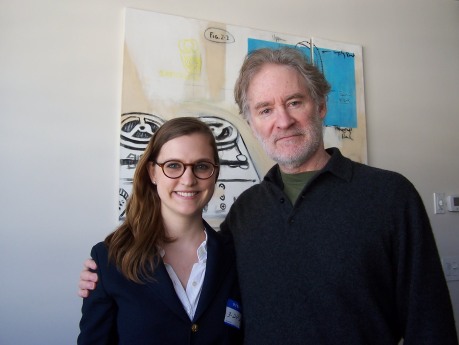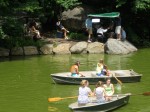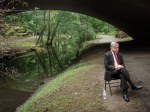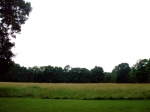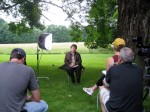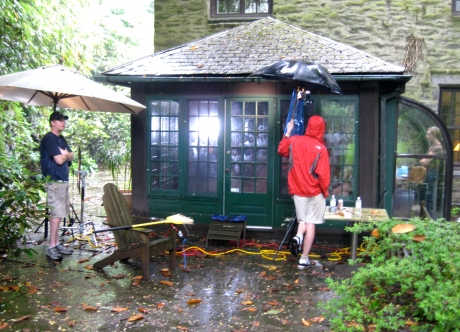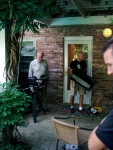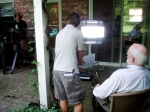WATCH NOW on thirteen.org!
April 21, 2011
Coming to the Nation’s Capital on March 23
March 13, 2011
Join parks experts and policy makers as we screen OLMSTED AND AMERICA’S URBAN PARKS at the National Museum of Women in the Arts in Washington, DC on March 23 at 7:00PM, as part of the Environmental Film Festival in the Nation’s Capital.
Wednesday, March 23: Environmental Film Festival in the Nation’s Capital, WASHINGTON, DC
7:00PM, National Museum of Women in the Arts
Deborah Gaston, Director of Education, National Museum of Women in the Arts will introduce. Discussion with filmmaker Rebecca Messner will follow.
$5, members/students/seniors $4. To purchase email reservations@nmwa.org or call202-783-7370.
OLMSTED on public television in April!
March 9, 2011

That time has come! April, 2011 brings OLMSTED AND AMERICA’S URBAN PARKS (formerly “The Olmsted Legacy”) to a television station near you, via American Public Television. Check your local listings for details, but below, a list.
| City | Station | Air Date/Time |
| Albany-Schenectady | WMHT | April 20, 10 p.m. |
| Albuquerque | KNMD | April 24, 6 p.m. |
| Atlanta | WPBA | April 23, 7 p.m. |
| Baltimore | MPT2 | April 21, 11 p.m. |
| Birmingham | WBIQ | April 21, 9 p.m. |
| Buffalo | WNED | Date TBD |
| Charlotte | WTVI | April 20, 11 p.m. |
| UNC-TV | April 28, 10 p.m. | |
| Chattanooga | WTCI | April 18, 10:30 p.m. |
| Detroit | WTVS | Date TBD |
| Fort Myers | WGCU | April 20, 10 p.m. |
| Fresno | KVPT | April 19, 9 p.m. |
| Grand Rapids | WGVU | April 24, 4 p.m. |
| April 26, 2 a.m. | ||
| Greensboro | UNC-TV | April 28, 10 p.m. |
| Greenville-Spartansburg | UNC-TV | April 28, 10 p.m. |
| Hartford | CPTV | Date TBD |
| Jacksonville | WJCT | April 19, 9 p.m. |
| Las Vegas | KLVX | April 20, 10 p.m. |
| Los Angeles | KVCR | April 19, 8 p.m. |
| Miami | WPBT | April 20, 10 p.m. |
| Milwaukee | WMVS | Date TBD |
| New Orleans | WLAE | April 18, 10 p.m. |
| New York | WNET | April 20, 10 p.m. |
| WLIW | April 22, 2 p.m. | |
| CPTV | Date TBD | |
| Pensacola | WSRE | April 20, 9 p.m. |
| Phoenix | KAET | Date TBD |
| Philadelphia | WLVT | Date TBD |
| Pittsburgh | MPT2 | April 21, 11 p.m. |
| Plattsburgh | Mtn Lake PBS | April 21, 9 p.m. |
| Portland | KOPB | April 29, 10 p.m. |
| KOPB Plus | April 24, 8 p.m. | |
| Providence | RIPBS | April 27, 9 p.m. |
| LEARN Ch. | Date TBD | |
| CPTV | Date TBD | |
| Raleigh-Durham | UNC-TV | April 28, 10 p.m. |
| Reno | KNPB | April 19, 9 p.m. |
| Sacramento | KVIE | Date TBD |
| Salt Lake City | KUEN | Date TBD |
| San Francisco | KQED | April 24, 2 p.m. |
| KRCB | Date TBD | |
| South Bend-Elkhart | WNIT | April 20, 10 p.m. |
| Tallahassee | WFSU | April 21, 10 p.m. |
| Tampa | WEDU | April 21, 10 p.m. |
| April 26, 6 p.m. | ||
| Washington DC | MPT2 | April 21, 11 p.m. |
OLMSTED title change!
March 9, 2011
If you haven’t yet noticed on our website–the title of this film has been changed to OLMSTED AND AMERICA’S URBAN PARKS.
Same film, different name!

It’s a big week of festivals for Olmsted. First stop in Nevada City, California on Saturday night at the Wild & Scenic Environmental Film Festival, and then on to Princeton, NJ for the Princeton Environmental Film Festival on Tuesday, January 18.
THE OLMSTED LEGACY joins films and filmmakers from across the globe, and will screen at 7:00pm at the Princeton Public Library – 65 Witherspoon Street, Princeton, NJ. Executive Producer Mike Messner (writer of this recent op-ed in the Washington Post: “Sometimes money does grow on trees” ) will discuss the genesis of the idea for the film and his efforts to keep Olmsted’s vision alive today.
Olmsted’s landscapes, I like to believe, are both wild and scenic, despite being surrounded by decidedly un-wild and un-scenic urban landscape. Therefore, I’m thrilled that the film was accepted to this year’s Wild & Scenic Environmental Film Festival in Nevada City, California.
If you find yourself in California on Saturday evening, east of the Sierra Nevadas, stop by Nevada City! THE OLMSTED LEGACY will be playing at Vet’s Hall. I’ll be there, speaking after the film, and blogging updates!
– Rebecca
More chances to catch OLMSTED on WHUT!
January 6, 2011
If you missed last week’s premiere, don’t fret. There are still a few more chances to watch THE OLMSTED LEGACY on WHUT. Some of the times are on the early side, but there is always DVR. Watch it in HD if you can!
Saturday, January 8 at 10:00PM
Sunday, January 9 at 2:00AM
Sunday, January 9 at 6:00AM
Read executive producer Mike Messner’s editorial in the Washington Post, “Olmsted’s ideals could help solve our real estate mess”.
He writes:
Olmsted designed transformative parks, campuses and greenways; his firm completed an amazing 6,000 commissions and launched a green wave across 19th-century America. The same kind of wave could help resolve the 21st-century real estate mess.
We don’t have the luxury of vacant land that Olmsted often started with, so we must bulldoze underperforming and underused property, put people to work creating parks on some of the land and “bank” the rest until the economy recovers.
A big idea, for certain, but we all know Olmsted was a fan of big ideas! Read more about Red Fields to Green Fields, Messner’s nationwide research initiative, below:
Washington Post Review
January 3, 2011
Thanks to everyone in the DC area who tuned into THE OLMSTED LEGACY on WHUT last night!
We are thrilled with this recent review in the Washington Post:
“A well-timed look at architect of American parks”
Says WaPo staff writer Emily Yahr:
As the holidays end, Christmas lights darken and the city settles in for the frigid winter months, an inconspicuous and intriguing documentary makes its television debut and reminds us of the simple joy of sitting outside in the sunshine.
Keep checking back for more info on opportunities to see THE OLMSTED LEGACY in a city near you!
WATCH January 2nd at 8pm on WHUT!
December 14, 2010
January 2nd, 8:00pm on WHUT in the Washington, DC metro area!
BROADCAST PREMIERE on WHUT in Washington, DC: January 2, 2011 at 8:00pm!
December 12, 2010
Tune into WHUT available in the Washington, DC metro area, at 8:00pm on Sunday, January 2nd, 2011 for the broadcast premiere of THE OLMSTED LEGACY: AMERICA’S URBAN PARKS featuring the voices of Kevin Kline and Kerry Washington!
OLMSTED returns to New York!
November 17, 2010
TOMORROW the New York City Department of Parks and Recreation hosts a screening of THE OLMSTED LEGACY back where it all began… at the Arsenal in Central Park (where the original Greensward Plan is housed!). The event kicks off at 6pm with an introduction by NYC Parks Commish (and TOL interviewee) Adrian Benepe.
Hear Benepe talk about his early days as a Central Park ranger, where he witnessed drug busts at the beautiful Bethesda Terrace, HERE
To RSVP for tomorrow’s screening, call 212 360 1324.
Next stop – CLEVELAND!
October 26, 2010
Cleveland State University’s Levin College of Urban Affairs teams up with ParkWorks to host tomorrow’s screening of THE OLMSTED LEGACY:
4:00-6:00 PM
Dively Auditorium, First Floor
Maxine Goodman Levin College of Urban Affairs
Glickman-Miller Hall, Roberta Steinbacher Atrium
Come for the film, stay for a discussion with local landscape architect Jim McKnight, and Tony Coyne, Chairman of the City Planning Commission.
See you tomorrow…
TONIGHT at the deYoung Museum, San Francisco
October 19, 2010
When San Francisco city leaders called on Olmsted in the 1860s, they were expecting to get another Central Park.
The park for San Francisco that Olmsted designed, however, was multi-faceted, featuring a smaller park in the wind-protected valley of the undeveloped Buena Vista Hill (modern day Hayes Valley), and a 4-mile promenade that ran along Market Street, before turning the corner and continuing up Van Ness Avenue to the bay. Olmsted thought the promenade should be lined with dry weather plants, and sunken underground, to protect pedestrians from the harsh east-west winds. City leaders thanked him for his time, paid him his $500 consulting fee, and ultimately decided that the idea was too radical, too far-sighted to be implemented.
Golden Gate Park, the “Central Park” that city leaders were looking for, was designed by William Hammond Hall on an epic stretch of land that Olmsted deemed too windy to be considered.
Join us TONIGHT for a screening of THE OLMSTED LEGACY at the deYoung Museum in Golden Gate Park.
7:00 PM
The screening is FREE, and will feature a Q&A with writer/producer Rebecca Messner, and remarks by Elizabeth Goldstein, president of the California State Parks Foundation. Many thanks to the San Francisco Parks Trust for their help with this event!
Screening at the NATIONAL ZOO in WASHINGTON, DC tomorrow!
October 13, 2010
Join us for a free screening of THE OLMSTED LEGACY: AMERICA’S URBAN PARKS at the National Zoo in Washington, DC! Tomorrow, October 14, 6:30 – 8:00 PM.
Hosted by our friends at the Smithsonian National Zoological Park and Friends of the National Zoo!
Come hear a special panel discussion following the film about the future of America’s urban parks, featuring Charles A. Birnbaum (founder and president, The Cultural Landscape Foundation), Faye Harwell (director and partner, Rhodeside & Harwell), Susan Rademacher (parks curator, Pittsburgh Parks Conservancy) and TOL interviewee Tupper Thomas (administrator, Prospect Park and president, Prospect Park Alliance)!
And stay for drinks and small bites!
Buffalo – the land of the parkway
August 30, 2010
Some photos from our screening of THE OLMSTED LEGACY: AMERICA’S URBAN PARKS in Buffalo, NY last Thursday. Many thanks to the Buffalo Olmsted Parks Conservancy for not only organizing a beautiful event, but for keeping Olmsted’s legacy truly alive and thriving in Buffalo.







Summer/Fall Screening Schedule
August 19, 2010
Below, a schedule of screenings of THE OLMSTED LEGACY: America’s Urban Parks
August 27 – Buffalo, NY at the Marcy Casino in Olmsted’s Delaware park
September 22 – Boston, MA at the Museum of Fine Arts
September 26 – Baltimore, MD at the Reginald F. Lewis Museum (2pm)
September 28 – Louisville, KY at the Speed Art Museum
October 19 – San Francisco, CA at the deYoung Museum, Golden Gate Park
Please check back for more details!
 [The premiere of “The Olmsted Legacy: America’s Urban Parks” in Prospect Park on August 4. Photo by Eugene Patron]
[The premiere of “The Olmsted Legacy: America’s Urban Parks” in Prospect Park on August 4. Photo by Eugene Patron]
Hope you can join us! And don’t forget to stop by the Dairy, Central Park’s visitor center, to watch “The Olmsted Legacy” at any time!
The Olmsted Legacy in Vaux’s Dairy, Central Park
August 17, 2010
Stop by the Dairy in Central Park to catch The Olmsted Legacy, playing on loop, starting today!
 [photo via the Central Park Conservancy]
[photo via the Central Park Conservancy]
The Dairy, intended by Calvert Vaux to be built as a refreshment stand for children, was meant to sell fresh milk at low prices, during a time when most of the milk in New York made citizens sick. “Swill milk,” as it was called, was taken from cows who were fed old mash leftover from the beer making process, at a time when the production and sale of milk in New York was not regulated.
Olmsted and Vaux, as a result, hoped to include fresh milk in their park as a kind of alleviating alternative to the other tainted options, and even designed a place for cows to graze and be milked in the vicinity of the Dairy.
The structure, however, underwent a significant transformation during the Tweed administration, and by the time construction was completed, there were no cows to be found. Olmsted’s sheltering vegetation was uprooted, and a carriage lot was constructed for the introduction of a restaurant for middle-class New Yorkers, which is how the space was used until the 1950s, when the building was virtually abandoned.
Today, the Central Park Conservancy’s brilliant restoration of the building now houses the park’s visitor center and gift shop. Still a far cry from Vaux’s original intention, but undeniably more useful for today’s park-goers than a lot full of cows!
The Dairy is open Monday-Sunday, 10am to 5pm, and will be continuously playing The Olmsted Legacy, beginning today. A great way to stay cool in these last days of summer.
Denver Screening of The Olmsted Legacy
August 13, 2010
Fresh off the premiere in Prospect Park, The Olmsted Legacy screened for parks leaders and policy makers in Denver on Wednesday. We were thrilled to be joined by Denver Parks Commissioner Kevin Patterson, Catherine Nagel of the City Parks Alliance, urban parks guru Peter Harnik, and Jonas Olmsted, distant relative of FLO himself, and, as an architect, living torchbearer of the Olmsted legacy.
We couldn’t have asked for a more beautiful setting. City Park set the stage in Denver not only for the film, but incomparable views of the city’s skyline, and its characteristic Rockies in the distance.
[City Park, Denver]
[Catherine Nagel, Peter Harnik, Rebecca Messner]
New Website!
July 29, 2010
New website launches today, featuring more information about the film, a teaser, and extended interviews.

In our extended interviews, hear Michael Dukakis talk about urban renewal in Massachusetts, NAOP founder Betsy Shure Gross explain the importance of public-private partnerships in park conservancy, and New York City Parks Commissioner Adrain Benepe recall the important role parks played on September 11.

Join us! THE OLMSTED LEGACY, featuring the voices of Kevin Kline and Kerry Washington, premieres in Olmsted and Vaux’s classic park–under the stars, and free for all.
Wednesday, August 4
8pm
The Celebrate Brooklyn! Stage at the Bandshell, Prospect Park.
Extended interviews coming soon to our new website
June 8, 2010
 [Betsy Shure Gross and Arleyn Levee in an extended interview for theolmstedlegacy.org]
[Betsy Shure Gross and Arleyn Levee in an extended interview for theolmstedlegacy.org]
Here’s a list of extended interviews you’ll find on our new website, coming soon:
Charles Beveridge – Author, Frederick Law Olmsted: Designing the American Landscape; series editor, The Papers of Frederick Law Olmsted, Department of History, American University, Washington D.C.
Witold Rybczynski – Meyerson Professor of Urbanism, University of Pennsylvania; author, A Clearing in the Distance: Frederick Law Olmsted and America in the Nineteenth Century. Architectural Critic for Slate magazine.
Arleyn Levee – Former chairperson, National Association of Olmsted Parks; board member, Emerald Necklace Conservancy; Olmsted historian.
Betsy Shure Gross – Co-founder, National Association of Olmsted Parks; former vice president, Emerald Necklace Conservancy; board member, City Parks Alliance.
Adrian Benepe – Commissioner, New York City Department of Parks and Recreation.
Doug Blonsky – President, Central Park Conservancy; administrator and landscape architect, Central Park.
Sara Cedar Miller – Official historian and board member, Central Park Conservancy; author and photographer, Central Park, An American Masterpiece and Seeing Central Park: The Official Guide to the World’s Greatest Urban Park.
Tupper Thomas – President, Prospect Park Alliance; administrator, Prospect Park.
Michael Dukakis – Former governor, Commonwealth of Massachusetts; Democratic nominee for US President in 1980; professor of political science, Northeastern University.
Morrison Heckscher – Lawrence A. Fleishman Chairman of the American Wing, Metropolitan Museum of Art; author, Creating Central Park.
Margaret Dyson – Director of historic parks, Boston City Parks and Recreation.
Alan Banks – Supervisory Park Ranger, Fairsted: Frederick Law Olmsted National Historic Site.
With his Shakespearean training, capacity for humor and strong connection to Central Park, we thought Academy Award-winning actor Kevin Kline was the perfect choice to make the words of Frederick Law Olmsted come to life.
We were especially excited to hear him lend his voice to evocative lines like these:
Olmsted’s Voice: “The time will come when New York will be built up, when all the grading and filling will be done, and when the picturesquely-varied, rocky formations of the Island will have been converted into foundations for rows of monotonous straight streets, and piles of erect, angular buildings. There will be no suggestion left of its present varied surface, with the single exception of the Park.”
Many thanks to our friends at the Central Park Conservancy for making this happen!
City blogs are abuzz about this website that’s showcasing one foundation’s proposal to turn Manhattan’s verdant gem (which they call “New York City’s largest remaining undeveloped parcel of land”) into…
 …an airport!
…an airport!
I was sent the site by a friend, and for a few gullible moments, before Google and some reputable blogs proved me otherwise, I was at once terrified and outraged, almost to the point of tears.
Rest assured, the site’s believed to be a fake, as is the foundation, called “The Manhattan Airport Foundation,” which, among other giveaway clues, has its offices at 233 Broadway, on the 58th floor of a building that has only 57.
What was especially clever of “The Manhattan Airport Foundation” is their inclusion of an “interview” with Dr. Harriet Worth, who claims to be the 5th generation grand-niece of Frederick Law Olmsted himself, and is supposedly visiting-chair of the Environmental Studies Graduate Department at HKI (what’s HKI? Hong Kong Institute? It’s unclear.).
The article is titled “What Would Olmstead [sic] Do? Ancestor Sheds Some Light.” “Worth” for the most part begins with a few accurate snippets about her great uncle x5’s urban theories:
“Part of the reason Olmsted is regarded as a visionary is that he was a master of illusion. His outdoor spaces seem to exist so naturally as to give the impression of predating the surrounding environs. Of course those familiar with his designs know each is a highly-curated, carefully-designed sleight of hand. The rock outcroppings, the reservoir, all of it man-made.”
Of course the reservoir was man-made. It’s a reservoir. Anyway, let’s not get finicky.
She goes on, however, to insist that green space in Manhattan, what with High Line park and all those “urban greenways” has become overly abundant, and now should be trumped by “improved access to transportation, creation of jobs for our skilled workforce, and the need to address myriad environmental wrongdoings.”
What would Olmsted say about the Manhattan Airport? Here’s the best part:
“Olmsted was no sentimentalist. He was nothing if not a pragmatist. For him Manhattan Airport would be that all-so-rare second chance to finally realize his original vision and intent… He would see this project as a bold opportunity to rise above the dated 19th century concept of catharsis-via-nature: The chance to finally realize his goal of an unparalleled urban oasis fostering the type of transformative experience that only a mixed-use international transportation hub can provide.”
Besides the fact that one of Olmsted’s firmest beliefs lay in the fact that catharsis-via-nature is a timeless concept, his biggest pet peeve was with people who viewed park land as “undeveloped space.” Clever interview, but I like to think the idea would give him hives, like it did me.
In any case, we thought we’d pinned down every last descendant of FLO’s. Maybe we missed this one, being that she’s on the other side of the world. We’ll ask around. Funny, though, Google “Dr. Harriet Worth,” and you’ll be directed to Harriet Worth’s IMBD page, where you’ll learn that she was second assistant director of the 2008 movie “Doomsday.” Appropriate.

A perfect evening in Central Park (via nytimes.com)
The New York Times brings news today about an evening in the park gone very nearly perfectly right.
It was 6:15 on Tuesday evening, a breezy, golden 77 degrees, and people were streaming into the park with plastic bags of picnic food, like pilgrims bearing offerings, for one of the city’s great summer rites: At 8 p.m., on the grassy oval ringed by oaks, skyscrapers and the almost-too-cute turrets of Belvedere Castle, the New York Philharmonic would start to play. Free.
“It’s really relaxing — and almost therapeutic in a certain kind of way when you’re out running around and having people bump into you in the subway — to have this music under the stars,” Mr. Nerio said. “It almost sounds cheesy, but it’s perfect.”
Olmsted could not have said it better himself:
“Is it doubtful that it does men good to come together in this way in pure air and under the light of heaven, or that it must have an influence directly counteractive to that of the ordinary hard, hustling working hours of town life?”
– Frederick Law Olmsted, in his 1870 essay,
“Public Parks and the Enlargement of Towns”
East Coast Shoot, Day 12, continued: loving Central Park
July 10, 2009
When you ask Sara Cedar Miller what her favorite part of Central Park is, she responds:
“OK. Pretend I have ten children. You’re really going to ask me which one’s my favorite?”
Her relationship with the park really is like that of a mother and child–Miller, fresh out of art school in 1984, joined the Central Park Conservancy in its infancy, as park photographer. Since then, she’s watched the park “grow up” into the beautiful urban oasis it’s become, and she knows the place as well as she would her own children.
“Oh, they’ve gotten so big,” she croons passing a family of ducklings waddling along the banks of The Lake, as we make our way towards a quiet clearing in the Ramble across from Bethesda Fountain.

The historian talks about her park sitting on one of Vaux's rustic benches, restored by the Conservancy
It was our last day of our East Coast Tour, and Miller seemed to be the perfect voice to close our long series of interviews. Today she also acts as the Conservancy’s official historian, a position she acquired in 1989. She has photographed and written about the park for two beautiful books: Central Park, An American Masterpiece, and Seeing Central Park. Poised and passionate, her face instinctively brightens when she talks about Central Park, often leaning in, treating the subject like it’s this incredible, fascinating secret she just can’t wait to let you in on.
Which isn’t to say she’s not full of incredible, fascinating secrets. She’s an adamant Vaux supporter, and won’t hesitate to let you know that the credit Olmsted gets for Central Park, though deserved, is not entirely fair. “The story of Central Park,” she says, “is really a story about Calvert Vaux getting Frederick Law Olmsted to join him in the design competition. Olmsted said no at first.”

Miller's latest book, "Seeing Central Park"
The Greensward Plan that Vaux eventually convinced Olmsted to complete with him is what she calls “a beautiful and very simple tapestry.” Vaux, she says, “really had the aesthetic and practical senses that Olmsted lacked. Vaux was very enamoured of the rough and wild Hudson River Valley,” where he had worked with his partner, Andrew Jackson Downing, designing estates for the well-to-do. “Olmsted loved the rolling hills of England. It was the melding of all these kinds of styles that was really a new style.”
Why does Olmsted receive all the credit, then? “He was the writer,” she says.
She’ll also tell you about how Robert Dylan, Central Park commissioner, and August Belmont, influential businessman and avid equestrian (for whom Belmont race track in Long Island is named), made a list of 17 changes to the Greensward Plan the day after it won the design competition. One of these proposed changes included a bridge that would allow people to transverse The Lake, walking easily from Bethesda Terrace to the Ramble. This turned into Bow Bridge, one of the most iconic images of the park today.
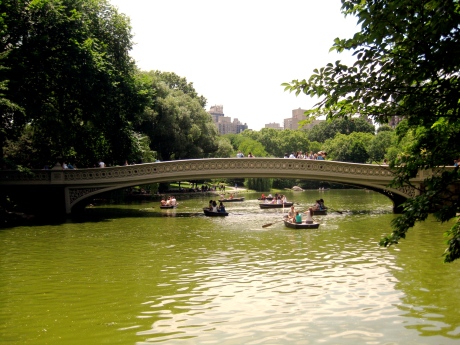
Bow Bridge--Vaux designed, Dylan and Belmont inspired
What would New York be without Central Park? We ask her. “New York would not be New York without Central Park.”
And who would she be without it? She smiles, her eyes moisten. “It’s my life’s work. It would be like not having an arm or a leg.”
Morrison Heckscher, the Lawrence A. Fleishman chariman of The American Wing at the Metropolitain Museum of Art, can recognize American art when he sees it. Central Park, the subject of his 2008 book, and also the verdant backyard of his museum, is not just a place for New Yorkers to seek shade, he holds, but one of this country’s great works of art.
As creators of Central Park, Heckscher called Olmsted and Vaux “towering figures in the history of American cities, of American landscape.” Olmsted, he said, was “the father, the dean of American landscape, particularly as it has to do with city parks.”
But it was William Cullen Bryant and Andrew Jackson Downing, he insists, who were really responsible for sparking the original initiative to create a major park in New York City. Downing, one of the great dictators of public taste in the early 19th century (Sara Cedar Miller calls him the Martha Stewart of the time period), was founder and editor of the magazine The Horticulturist, and also a popular landscape architect with his partner, Calvert Vaux. Downing acted as a kind of mentor to Olmsted, publishing some of Olmsted’s first writing, and inspiring his interest in the young profession of landscape architecture. Bryant, poet and longtime editor of the New York Post, helped give Downing’s plea for Central Park in 1851 a voice that would be heard by the public.
Title page of an edition of The Horitculturist
In fact, it is generally assumed that had Downing not died in 1852 in a tragic steamboat accident at the age of 36, he would have been the logical choice to be designer of the park. After his death, Olmsted was approached by the newly partnerless Vaux to enter the design competition, which they of course won in 1858.
Though the circumstances of the launch of his career arguably depended on the doomed fate of another man, Olmsted, Heckscher holds, is an artist, and Central Park, “literally, a series of works of art.” In particular, Heckscher cited the views that Olmsted and Vaux carefully planned within the park, which tend to appear suddenly, framed by elements of the landscape and “set low within the landscape–one comes upon them walking through the park.” Heckscher calls this “an extroadinary but very subtle architectural satement.”
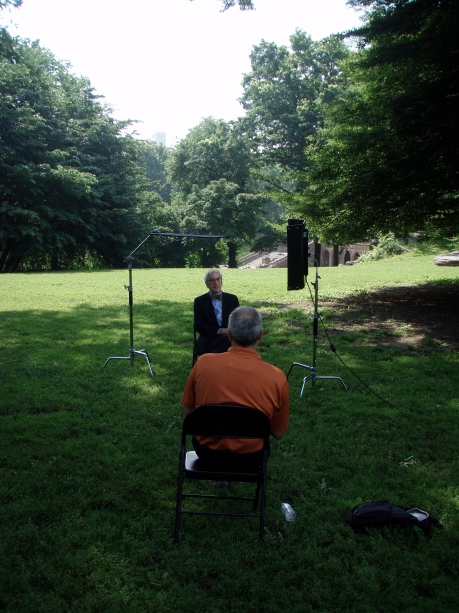
interviewing Morrison Heckscher, with a view of Bethesda Terrace
What is the difference, we asked, between the park and the great works that hang in frames from the walls of the Met? “The extensive difference is its dynamism, the fact that it’s alive,” he said. “There’s no way that one can freeze a park within a certain moment. Olmsted and Vaux envisioned mature plants and trees, but eventually that moment passes, and the trees go. The challenge, in moving ahead,” he says of the future of the park, “is recognizing that [the plants and trees of the park] are not static.”
Charles Beveridge called Prospect Park “a classic example of [Olmsted and Vaux’s] concept of a great urban park,” and “the most pleasing that they created during their collaboration.”
Olmsted himself had this to say to those involved in the construction of the park in 1865:
“We must study to secure a combination of elements which shall invite and stimulate the simplest, purest and most primeval action of the poetic element of human nature, and thus remove those who are affected by it to the greatest possible distance from the highly elaborate, sophistical and artificial conditions of their ordinary and civilized life.
Thus it must be that parks are beyond anything else recreative, recreative of that which is most apt to be lost or become diseased and debilitated among the dwellers in towns.”
Prospect Park has the unique quality of seclusion in New York City. Where the tall buildings of Manhattan which surround Central Park have come to act as artistic framing elements, Brooklyn benefits from being significantly shorter. Walking through the park today truly offers the illusion of rurality, which Olmsted and Vaux so adamantly sought to create.
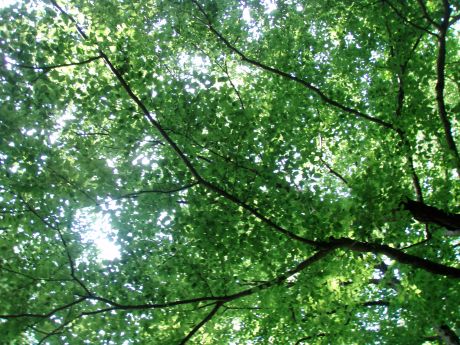
The canopy in the Ravine, Prospect Park. This is Brooklyn we're in, you say?
Tupper Thomas, who became Administrator of Prospect Park in 1980, and has acted as President of the Prospect Park Alliance since its formation in 1987, prefers to do less talking, more showing when it’s time to convince people of the park’s value.
“I don’t talk history and preservation,” she says. “I take people to look at it, and I say, ‘Look how beautiful this is!'”
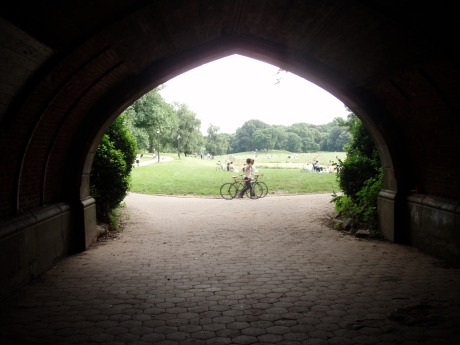
The view of the Long Meadow through Endale Arch

The Vale of Cashmere
She still, though, has plenty to say on the topic:
“It’s gorgeous, multi-use, brilliant in its design, and it’s everlasting. Even today the park still replenishes your soul, does wonderful things for your psyche. It’s still what people need.
The fun thing to do is give people a tour of the park, and tell them it’s designed. The art of [Olmsted and Vaux’s] design is that it doesn’t look like design.”

Evidence of the design--a photo from circa 1874 of construction on Prospect Park, by the entrance at Grand Army Plaza
There are no transverse roads that cut horizontally through Prospect Park, a fact which allows it to get away with the Long Meadow, the longest unbroken meadow in any urban park in America. Prospect Park also posesses 120 acres of woodlands, which shelter tinier meadows of their own, and a 60 acre lake.
Our interview with Tupper Thomas took place on a Saturday afternoon in the Long Meadow. We were surrounded by park users–there to picnic, scooter down paths, play soccer, and celbrate birthdays, which gave the background of our shot some colorful dynamism.

Tupper Thomas

cue the cute kids with balloons...

group photo with Tupper Thomas
The Long Meadow in Prospect Park is arguably the happiest place in the world in the hours before 9am on Saturdays.
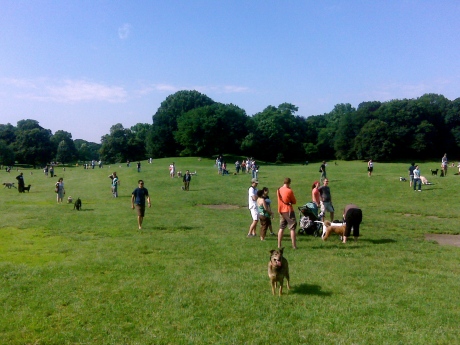
Saturday, 8am, happy pups
The off-leash initiative started in the 1980s, when Tupper Thomas, Prospect Park Administrator, and now president of the Prospect Park Alliance, needed a way to get people back in the park. Dogs are allowed to be off-leash in the park from 9pm to 1am, when the park closes, and from 5am to 9am in the morning.
Our crew was able to catch a beautifully joyous scene at around 8am on Saturday, June 27. I racked my brain to no avail to see if I had ever been in one place with so many dogs. We strolled among the throngs of dogs and their owners, many of whom also had adorable babies in tow. The cuteness factor was almost too much to handle.
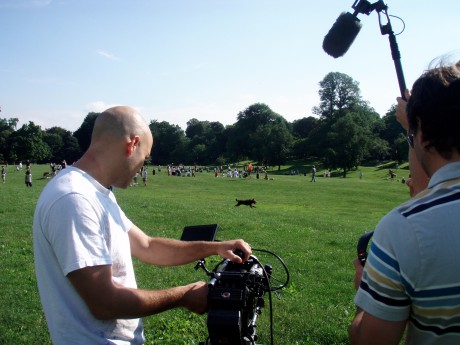

Who knows if Olmsted could have forseen the popularity of this particular activity–early on, in the late 1800s, dogs did come to the park–leashless, it seems–but presumably in the interest of tending sheep. Tennis ball launchers, of course, had not yet been invented.

Dogs and sheep in the Long Meadow, circa 1900-1905
With no sheep to tend to on Saturday, the raucous canine party left virtually no mess behind them, and by 9am, the dogs were diligently leashed back up and led either to the shaded paths of the Ravine, or the surrounding streets. Later, when I asked Tupper about this incredible display of public respect for the park, she told me about the organization FIDO. FIDO stands for “Fellowship in the Interest of Dogs and their Owners,” and is a community organization that works with the park to educate off-leashers about park rules, while encouraging the maintenance of a safe and healthy place for dogs. Read more about FIDO here: www.fidobrooklyn.org.
It was a gorgeous day in Central Park. The early summer heat was not yet oppressive, and visitors to the park came out in happy hordes.
We sat with Adrian Benepe, commissioner of New York City Parks, in a section of the Ramble, the woodlands area just north of Bethesda Terrace in Central Park, on an elegant bank that gave us an exquisite view of Bow Bridge. On that Friday afternoon, we all felt like we’d arrived at the Four Seasons of city parks: the lake was filled with joyous (and noisy) boaters, the grass was expertly manicured, Bethesda Terrace and Bow Bridge were shining, nary a napkin or water bottle lay on the ground, and there was soap in all the public bathrooms.
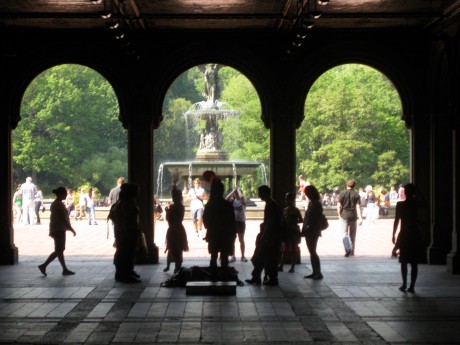
Then the Commissioner told us a story about how, when working as a park ranger here in 1979, he almost got shot during a drug bust, mere feet from the clean, peaceful oasis of green in which we were sitting. “I was walking along that path,” he said, motioning to the footpath that leads from Bethesda Terrace to Bow Bridge, “when I heard someone shout, ‘Don’t move [expletive]!’ Then there were gunshots, and I got down on the ground.” Animated, he described the ensuing chase, and the kung-fu kick that the officer laid into the drug dealer’s back, taking him down on the ground.
Bethesda Terrace, the romatic spot of weddings and bluegrass quartets that we witnessed this past weekend, mere decades ago was one of the most notorious spots for drug dealing in the city. Olmsted and Vaux’s vision, which Benepe described as “effectively creating palace grounds for common people,” in the 1970s and early 1980s, was covered with graffiti and litter.

Commissioner Benepe and Bow Bridge
How did the city make the turnaround? “You need to shoot for perfection,” he said. “You should create a wonderful and elegant park experience, and people will rise to it…Litter attracts litter. Graffiti attracts graffiti,” he said, meaning, essentially, if you build it, they will come.
And come, they have.
- Commissioner Benepe and Bow Bridge
- Watching the shoot from Bow Bridge
- crafting the shot
- Sam Shiverick and Corey Stienecker provide shade
- Group photo with Commissioner Adrian Benepe
Sara Cedar Miller, historian and photographer for the Central Park Conservancy, and author of the beautiful books Central Park: An American Masterpiece and Seeing Central Park once candidly called Doug Blonsky the Frederick Law Olmsted of today.
Blonsky is president of the Central Park Conservancy, as well as Chief of Operations of Central Park, which means he’s not only the leader of the organization that raises 85% of the park’s $27 million annual budget, but he manages a staff of over 250, and about 3,000 volunteers. Olmsted, in addition to creating the spectacular design for the park, was also superintendent, and later architect-in-chief of the park. A landscape architect by training, Blonsky calls Central Park “the soul of New York City,” and laughingly shrugged off Miller’s admiring comparison.
Shortly after 9/11, he said, “The park was the cathedral, it was the church, it was the temple,” going on to describe the masses of people who came out to the park.
He also did not hesitate to bring up one of Olmsted’s most convincing arguments for supporting urban parks. “A lot of people don’t stop to think about how important Central Park is for the economy,” he said, referencing the Central Park Effect, a report commissioned by the Conservancy in May, 2008, which estimated that visitors to the park generated $80 million in spending outside the park in 2007. “Real estate values,” he added, “quadruple within a 10-minute walk of the park.” Appleseed, the economic development consultants who released the report, posted an interesting article on how Central Park responded to the recession on their blog.
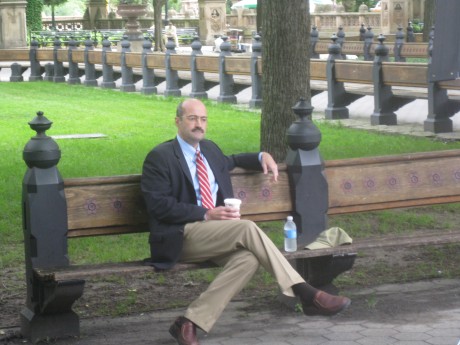
Interviewing Blonsky on Vaux's benches in the Mall in Central Park
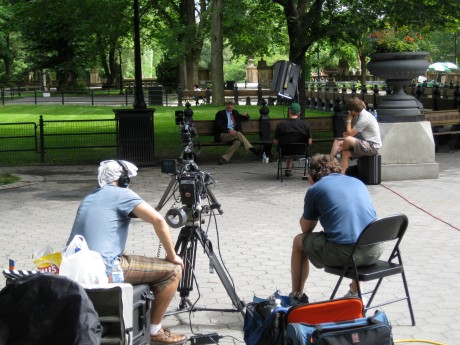
East Coast Shoot, Day 7: Central Park
June 25, 2009

Bethesda Fountain, circa 1880

Bethesda Fountain, 2009
East Coast Shoot, Day 6: “the powerhouse”
June 25, 2009
Our producer Michael White likes to call the dynamic duo Arleyn Levee and Betsy Shure Gross as Boston’s “powerhouse” of park advocates. I like to think of them as the godmothers of the Emerald Necklace restoration effort.
Levee, NAOP board member and John Charles Olmsted expert, told us, “Frankly, Olmsted gave the city of Boston its aesthetic shaping.”
Gross, who co-founded NAOP in 1980, when asked about the importance of the public/private partership in park restoration said “Honey, nothing can be done to change parks without the involvement of the private sector.”
Behind every great park is not only a great designer, but a fierce and determined army of advocates, who will not take no for an answer.
- A group photo with Alan Banks, Arleyn Levee and Betsy Shure Gross
- Arleyn Levee with George deGolian and Michael White, at Fairsted
- Arleyn Levee
- Arleyn Levee
- Arleyn Levee, Betsy Shure Gross and George deGolian
- the dynamic duo onscreen
East Coast Shoot, Day 5, continued: “a grand soft day”
June 24, 2009
Frederick Law Olmsted once wrote to architect Henry Van Brunt:
Suppose that you had been commissioned to build a really grand opera house; that after the construction work had been nearly completed and your scheme of decoration fully designed you should be instructed that the building was to be used on Sundays as a Baptist Tabernacle, and that suitable place must be made for a huge organ, a pulpit and a dipping pool. Then, at intervals afterwards, you should be advised that parts of it could be used for a court room, a jail, a concert hall, hotel, skating rink, for surgical cliniques, for a circus, dog show, drill room, ball room, railway station and shot tower?
That is what is nearly always going on with public parks. Pardon me if I overwhelm you; it is a matter of chronic anger with me.
It is fitting that I came across this quotation yesterday, the day we filmed an interview with Margaret Dyson, Director of Historic Parks for the city of Boston’s Parks and Recreation department, in Franklin Park. Franklin Park, one of the largest and last parks that Olmsted designed, is now home to a golf course, a hospital, a football stadium, and a zoo. Dyson remarked how this is one of the most common conflicts that exists, to this day, in the business of city parks. Cities, she said, often tend to view open space as empty space, ripe for the development of more “useful” structures.
She was happy, however, about the golf course, over which we filmed her interview, because at least it kept the large meadow open, retaining the Olmstedian pastoral. If you squint, and ignore the buzz of golf carts and the thwack of drives, it looks almost like you’re overlooking an English moor. Especially given the weather we had, which Dyson said her Irish ancestors would have called “a grand soft day.”
Dyson spoke passionately and eloquently about Olmsted’s legacy and the parks of Boston, and insisted that our cameraman/cinematographer/southern gentleman Teague Kennedy stop calling her “ma’am.”
- brainstorming interview questions
- Where are we, anyway? Scotland?
- School Master’s Hill, on the site where Ralph Waldo Emerson (school master and poet) once lived
- working with the rain
- Our soundman Mikey protects his gear while listening intently
- protecting Margaret Dyson from the rain
- Michael White, George deGolian and Rebecca Messner with Margaret Dyson
East Coast Shoot, Day 5: politicians and park advocates
June 24, 2009
I met former Massachusetts Governor and Democratic presidential candidate of 1988 at the Longwood T stop in Brookline, close to his house. It was 8:00 am, and I was scouring passengers as they got on and off the busy commuter trains, until a solidly swift-footed man with silver hair and a beige trench coat passed by me, headed straight for Olmsted Park, on the other side of the tracks. When I caught up with him, he gave me a politician’s handshake, and threw some encouraging words about our project at me as we walked to meet the crew. Once there, he nonchalantly tossed his briefcase on the wet grass and got straight down to business.
- Meeting Michael Dukakis at the Longwood T stop
- An interview along the Muddy River in Olmsted Park
- Group photo with Michael Dukakis
One of the most striking issues Dukakis mentioned in our 40-minute interview was park maintence. You can build all the parks you want, he said, but they’re virtually useless if not properly maintained. In fact, the former governor is famous for walking every day the two miles through the park to and from Northeastern University, where he teaches, picking up trash as he goes. Olmsted believed stridently in this as well, and, especially while working as superintendant of Central Park, was notoriously rigid about the number of hours he wanted maintence crews to work.
Dukakis referenced the Emerald Necklace Maintenence Collaborative, an initiative that brings inmates from local correctional facilities into the parks four days a week to cut grass, pick up trash, and perform other maintenence duties. On the fifth day, the program then provides them with horticultural and landscape training. The program has proved enormously succesful. To learn more about it, click here: http://www.emeraldnecklace.org/maintenance-collaborative/
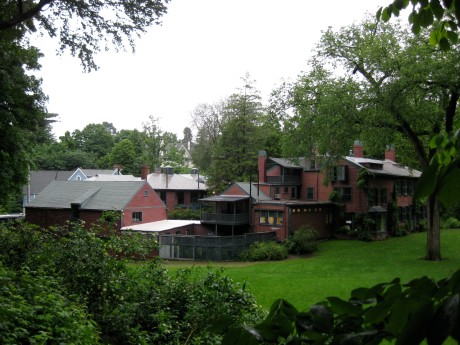
rear view, 2009
Alan Banks, supervisory park ranger for the Fairsted National Historic Site, described the house at the time Olmsted purchased it in 1883 as “a shrub with windows.”
In fact, Olmsted remarked, while drafting the plans to the house’s landscape with his stepson, John Charles Olmsted,
“I don’t object to the cutting away of certain bramble patches if brambles are to take their place–or anything that will appear spontaneous & not need watering or care. More moving or dug ground I object to. Less wildness and disorder I object to.”
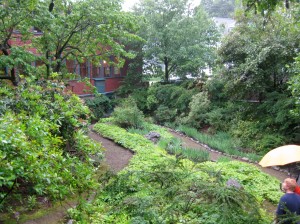
The crew shoots "the Hollow," the sunken garden of Fairsted.
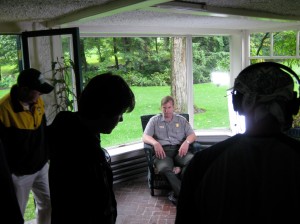
Alan Banks comments on Olmsted, parks, and the music of landscape architecture.
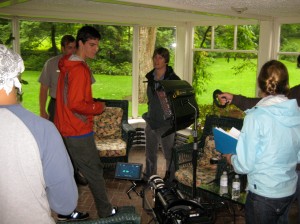
Olmsted's "out-of-door apartment" once again comes in handy. This time, thankfully, everyone fit inside.
East Coast Shoot, Day 4: rain, rain, rain
June 22, 2009
So, it’s not necessarily convenient that our three days in Boston are scheduled to be rain-filled with temperatures in the chilly mid 60’s (this is especially difficult for the Atlanta-based members of our crew, who came in their shorts and t-shirts, and are now saying “This is what December in Atlanta feels like!”). The rain makes filming challenging, to say the least.
It’s helpful to think of Olmsted in times like these, when the project you’re passionate about does not go entirely as you planned or as you’d like, when you run into obstacles completely out of your control, and are forced to rethink and re-strategize. Patience was one of the man’s most defining virtues.
And, looking on a brighter side, perhaps this abundance of wetness can also serve to remind us that Olmsted’s 1876 design for the Emerald Necklace, the park system that connects Boston Common to Franklin Park, began as a flood control project to improve the drainage and flow of the Back Bay Fens. Olmsted created shelved banks in the Fens, (and later along the Muddy River) sinking them below street level, providing valuable flood space for the river. He planted these banks with marsh vegetation, set paths along the river and created yet another park space that allowed visitors to separate themselves from the city.
We’re not sure that the rains here will reach flood-levels, but the water level sure is rising.

The Back Bay Fens, 1892
Tomorrow morning it’s an early interview with parks supporter and former Massachusetts governor and presidential candidate Michael Dukakis, in Olmsted Park in Brookline. Still to come, pictures and commentary on today’s interview with Alan Banks, Fairsted’s Supervisory Park Ranger.
Years later, Olmsted recalled a hike with his brother to his aunt’s house in Cheshire. “I was but nine when I once walked sixteen* miles over a strange country with my brother who was but six, to reach it. We were two days on the road, spent the night at a rural inn which I saw still standing a few years ago, and were so tired when we arrived that, after sitting before that great fireplace and being feasted, we found that our legs would not support us and were carried off to bed. It was a beautiful region of rocky glens and trout brooks.” I imagine their adventure. It is a sunny day. The dusty road outside Hartford winds its way through rolling meadows . Olmsted is in the lead, probably talking, pointing out birds and trees in the hedgerows along the verge. He is excited about the prospect of adventure. He holds his younger brother by the hand. John is less sure about the outing. He is thinking that perhaps they should go home before it gets too late. But he gets along, trusting that Frederick will find the way, as he always seems to do.
[from Witold Rybczynski’s A Clearing in the Distance]
*Olmsted, in his post-hike haze, must have miscalculated the distance he traveled. Cheshire, Connecticut, in fact, is nearly 30 miles from Hartford.
- Interviewing Jean McKee, distant cousin of FLO, at her family’s estate in Cheshire, CT
- The 1733 house at whose fireplace a 9-year-old FLO and his 6-year-old brother rested after having traveled nearly 30 miles
- Original stone wall dating to the early 1700’s
- A landscape so pastoral, it looks to have been designed by Olmsted himself
- interviewing Jean McKee
- Group photo with Jean McKee
East Coast Shoot, Day 2, continued.
June 21, 2009
More photos from the interview with Witold Rybczynski.
- pre-rain
- ominous wet drops on the ground, just after everything’s set up
- this would be what George likes to refer to as Olmsted’s “great reveal”
- Hi Sam!
- the crew with Rybczynski and his lovely wife, Shirley
East Coast Shoot, Day 2: protected from the elements
June 20, 2009
Olmsted believed that every house should have a room, full of windows, partially separated from the house’s main foundation, that would allow people to sit and enjoy the beauty of outside scenery, but with the protection of walls and a roof. There is a room like this in Fairsted, his estate in Brookline, Massachusetts.
Conveniently, there was also a room like this in the Philadelphia home of Witold Rybczynski, author of the acclaimed Olmsted biography, A Clearing in the Distance, and today’s main interview. The rain made an outside interview impossible (a shame, considering the author’s Olmstedian backyard), and so we chose what we’re sure Olmsted would have considered the second best location.
Protected from the elements. Some of us were, at least.
More photos from the shoot to follow.
East Coast Shoot, Day 1: no flowers, please
June 19, 2009
After completing the plans for Jackson and Washington Parks in Chicago in 1871, Frederick Law Olmsted showed his plans to one of the park commissioners for approval.
The commissioner, after reviewing his plans, made the following query to Olmsted in a letter:
“I don’t see, Mr. Olmsted, that the plans indicate any flower beds in the park. Now where would you recommend that these be placed?”
Olmsted wrote back, saying:
“Anywhere outside the park.”
Indeed, Olmsted was not a fan of flowers, and was notorious for excluding them in his plans for the great parks of the United States. Flowers, he upheld, were too beautiful in themselves to act as part of a coherent landscape, when that landscape’s purpose was to “unconsciously” affect those within it. His goal was to have people enter into a park and be subtly washed over with feelings of ease, without having to stop and say, “Look at that beautiful flower!”
This morning marked our first interview of the shoot, with Dr. Charles Beveridge: Olmsted scholar, editor of the Papers of Frederick Law Olmsted, and author of Frederick Law Olmsted: Designing the American Landscape, one of the most eloquently written books on the landscape artist and his works.
And so, fittingly, there was much discussion about what would appear in the background of his interview. The team decided on the backyard of Dr. Beveridge’s DC-area home–a carefully-planned shot that included lots of lush green, but no flowers (at one point, a blue hydrangea was weighed down with a backpack to avoid sneaking on camera).
Now for behind the scenes shots.
- Alexandria, VA
- Michael White and Teague Kennedy work the camera, while George deGolian stands in for Dr. Beveridge
- Ferns yes, hydrangeas no.
- Dr. Beveridge gives his approval
- The view from Dr. Beveridge’s chair
- Ready to roll…
“There is one large American town, in which it may happen that a man of any class shall say to his wife, when he is going out in the morning: ‘My dear, when the children come home from school, put some bread and butter and salad in a basket, and go to the spring under the chestnut-tree where we found the Johnsons last week. I will join you there as soon as I can get away from the office. We will walk to the dairy-man’s cottage and get some tea, and some fresh milk for the children, and take our supper by the brook-side;’ and this shall be no joke, but the most refreshing earnestness.
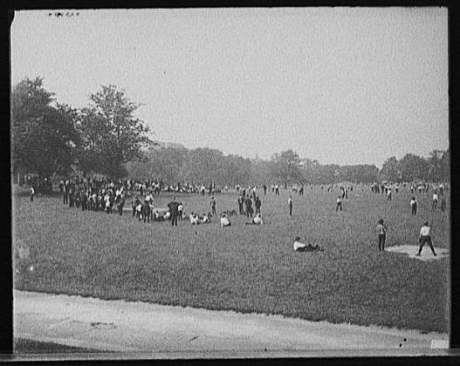
Central Park boys' playground. Photo taken between 1900 and 1910.
“There will be room in Brooklyn Park, when it is finished, for several thousand little family and neighborly parties to bivouac at frequent intervals through the summer, without discommoding one another, or interfering with any other purpose, to say nothing of those who can be drawn out to make a day of it, as many thousand were last year… Often they would bring a fiddle, flude, and harp, or other music. Tables, seats, shade, turf, swings, cool spring-water, and a pleasing rural prospect, stretching off half a mile or more each way, unbroken by a carriage road or the slightest evidence of the vicinity of the town, were supplied them without charge… In all my life I have never seen such joyous collections of people. I have, in fact, more than once observed tears of gratitude in the eyes of poor women, as they watched their children thus enjoying themselves… When the arrangements are complete, I see no reason why thousands should not come every day…to use them; and if so, who can measure the value, generation after generation, of such provisions for recreation to the over-wrought, much confined people of the great town that is to be?”
[Frederick Law Olmsted, from his essay, Public Parks and the Enlargement of Towns, 1870]











